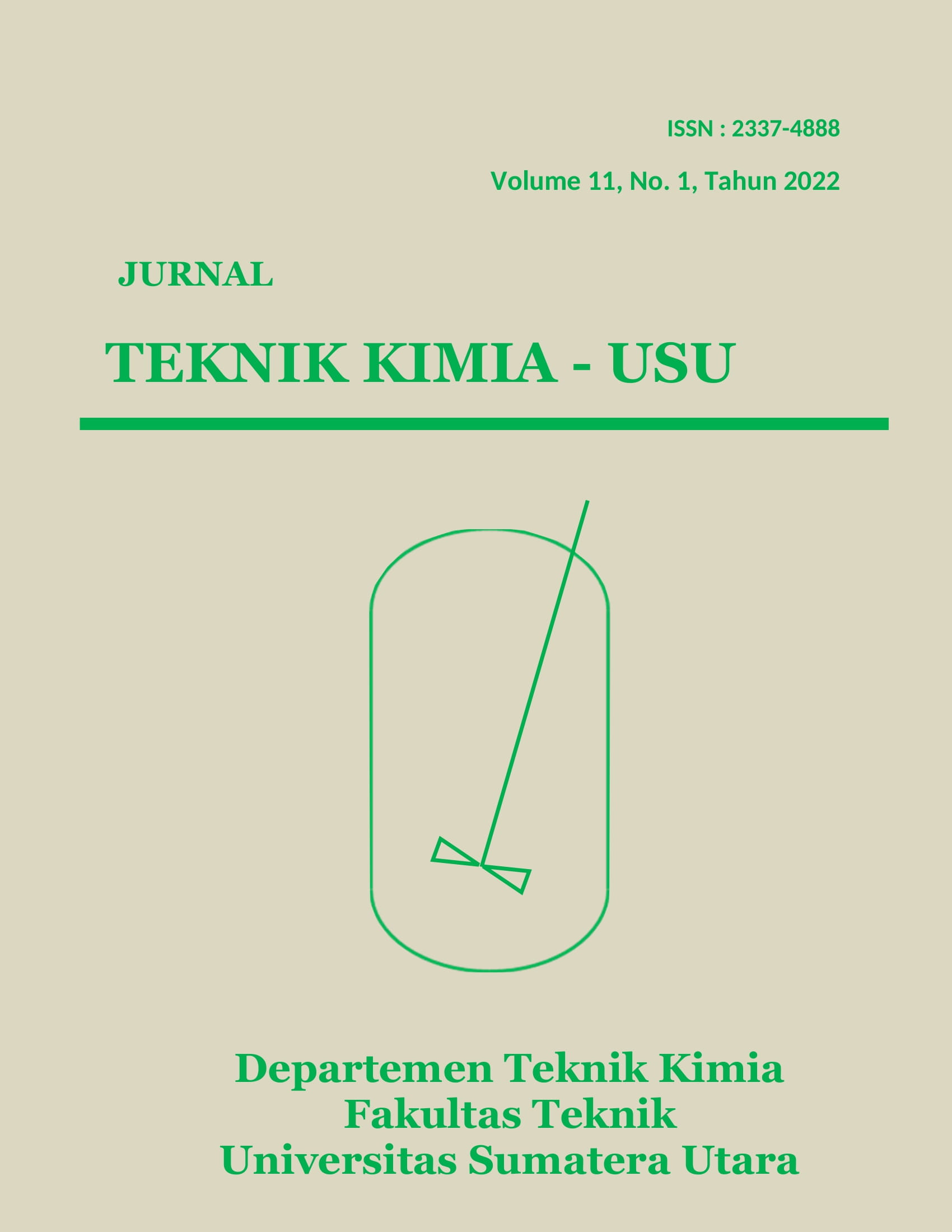Pengaruh Jarak Elektroda dan Tegangan terhadap Efektivitas Pengolahan Air Lindi dengan Metode Elektrokoagulasi-Adsorpsi Zeolit
DOI:
https://doi.org/10.32734/jtk.v11i1.8284Keywords:
adsorption, electrocoagulation, leachate, zeoliteAbstract
The problem that has been difficult to overcome until now is the waste problem. Landfilling remains a method that is often used but has a disadvantage in the form of leachate production. Leachate or leachate is defined as wastewater produced from Final Disposal Sites (TPA). The combination of electrocoagulation and adsorption methods can be a promising treatment technology. The electrocoagulation process was carried out for 1 hour using iron electrodes. The variations used are electrode distances consisting of 1 cm, 1.5 cm, and 2 cm while the voltages consist of 10 volts, 20 volts, and 30 volts. In adsorption, zeolite adsorbent was used with a residence time of 2 hours. The research stages started from the preparation of leachate samples, examination of initial characteristics, leachate treatment, and testing of COD, TSS, and pH. The results showed that the optimal variation was obtained at a distance of 1 cm and a voltage of 30 volts with a COD efficiency of 98.84% and TSS of 99.82%. For the pH value, the result is that the greater the distance between the electrodes and the voltage, the higher the pH value obtained.
Downloads
References
Anonim, Undang-Undang Republik Indonesia Nomor 18 Tahun 2008 Tentang Pengelolaan Sampah, UU Republik Indonesia, Indonesia, 2008, pp. 1–46.
N. Galvão, J. B. de Souza, and C. M. de Sousa Vidal, “Landfill leachate treatment by electrocoagulation: effects of current density and electrolysis time,†J. Environ. Chem. Eng., vol. 8, no. 5, pp. 1–8, 2020.
N. Huda, A. A. A. Raman, M. M. Bello, and S. Ramesh, “Electrocoagulation treatment of raw landfill leachate using iron-based electrodes: effects of process parameters and optimization,†J. Environ. Manage., vol. 204, no. 2017, pp. 75–81, 2017.
M. Bharath, B. M. Krishna, and B. Manoj Kumar, “Degradation and biodegradability improvement of the landfill leachate using electrocoagulation with iron and aluminum electrodes: a comparative study,†Water Pract. Technol., vol. 15, no. 2, pp. 540–549, 2020.
A. Takwanto, A. Mustain, and H. P. Sudarminto, “Penurunan kandungan polutan pada lindi dengan metode elektrokoagulasi-adsorbsi karbon aktif untuk memenuhi standar baku mutu lingkungan,†J. Tek. Kim. dan Lingkung., vol. 2, no. 1, pp. 11–16, 2018.
G. Hassani et al., “Optimization of landfill leachate treatment process by electrocoagulation, electroflotation and sedimentation sequential method,†Int. J. Electrochem. Sci., vol. 11, no. 8, pp. 6705–6718, 2016.
E. Bazrafshan, M. R. Alipour, and A. H. Mahvi, “Textile wastewater treatment by application of combined chemical coagulation, electrocoagulation, and adsorption processes,†Desalin. Water Treat., vol. 57, no. 20, pp. 9203–9215, 2016.
M. A. R. Syawalian, Y. Yohana, and A. Kahar, “Pengaruh kuat arus dan tegangan terhadap perubahan kandungan logam pada lindi TPA sampah dengan metode elektrolisis,†J. Chemurg., vol. 3, no. 1, pp. 6–10, 2019.
M. Bharath, B. M. Krishna, and B. M. Kumar, “Degradation and biodegradability improvement of the land fi ll leachate using electrocoagulation with iron and aluminum electrodes : a comparative study,†Water Pract. Technol., vol. 15, no. 2, pp. 540–549, 2020.
H. Sinaga, I. Amri, and I. HS, “Pemanfaatan teknologi elektrokoagulasi untuk pengolahan limbah cair industri tahu menggunakan elektroda AI-AI dengan variabel jarak elektroda dan kuat arus,†Jurnal Online Mahasiswa, vol. 6, no. 1, pp. 1–6, 2019.
S. H. Abbas and W. H. Ali, “Electrocoagulation technique used to treat wastewater: a review,†Am. J. Eng. Res., vol. 7, no. 10, pp. 74–88, 2018.
N. Fauzi, K. Udyani, D. R. Zuchrillah, and F. Hasanah, “Penggunaan metode elektrokoagulasi menggunakan elektroda alumunium dan besi pada pengolahan air limbah batik,†Semin. Nas. Inov. dan Apl. Teknol. di Ind., vol. 5, no. 4, pp. 209–214, 2019.
A. I. Saputra, “Penurunan TSS air limbah laboratorium rumah sakit menggunakan metode elektrokoagulasi,†J. Nurs. Public Heal., vol. 6, no. 2, pp. 6–13, 2018.
R. L. Hanastasia, A. Setiawan, and T. A. Ramadani, “Treatment of Pb(II) metal in wastewater using combination method of electrocoagulation − activated carbon adsorption,†J. Presipitasi Media Komun. dan Pengemb. Tek. Lingkung., vol. 17, no. 2, pp. 96–103, 2020.
C. Widiyati, “Pemanfaatan zeolit untuk penurunan COD dan BOD limbah pengolahan kulit,†Berk. Penelit. Teknol. Kulit, Sepatu, dan Prod. Kulit, vol. 12, no. 2, pp. 26–39, 2013.
Anonim, Air dan air limbah – Bagian 73: cara uji kebutuhan oksigen kimiawi (Chemical Oxygen Demand/COD) dengan refluks tertutup secara titrimetri (SNI 6989.73:2009), Badan Standardisasi Nasional, Indonesia, 2009, pp. 1–7.
Anonim, Air dan air limbah – Bagian 3: cara uji padatan tersuspensi total (TSS) secara gravimetri, Badan Standardisasi Nasional, Indonesia, 2019, pp. 1-7.
Anonim, Air dan air limbah - Bagian 11 cara uji pH (derajat keasaman) menggunakan pH meter (SNI 6989.11:2019), Badan Standardisasi Nasional, Indonesia, 2019, pp. 1–7.
Menteri Lingkungan Hidup dan Kehutanan Republik Indonesia, Peraturan Menteri Lingkungan Hidup dan Kehutanan Republik Indoneisa Nomor P.59/Menlhk/Setjen/Kum.1/7.2016 Tentang Baku Mutu Lindi Bagi Usaha dan/atau Kegiatan Tempat Pemrosesan Akhir Sampah, Indonesia, 2016, pp. 1–12.
I. B. Kartikasari, M. Widyastuti, and S. Hadisusanto, “Pengujian toksisitas lindi instalasi pengolahan lindi TPA Piyungan pada Daphnia sp. dengan whole effluent toxicity,†J. Ilmu Lingkung., vol. 18, no. 2, pp. 297–304, 2020.
I. Amri, Pratiwi Destinefa, and Zultiniar, “Pengolahan limbah cair tahu menjadi air bersih dengan metode elektrokoagulasi secara kontinyu,†Chempublish J., vol. 5, no. 1, pp. 57–67, 2020.
E. Saputra and F. Hanum, “Elektrokoagulasi terhadap pengolahan effluent the effect of inter electrode distance on,†J. Tek. Kim. USU, vol. 5, no. 4, pp. 33–38, 2016.
P. N. Setianingrum, A. Prasetya, and Sarto, “Pengaruh tegangan listrik, jarak antar elektroda dan waktu kontak terhadap penurunan zat warna remazol red rb menggunakan metode elektrokoagulasi,†Prisiding Semin. Nas. Teknol. Pengolah. Limbah XV, pp. 147–156, 2017.
A. Nugraha, I. Amri, and I. HS, “Pengaruh pola dan jarak elektroda pada proses elektrokoagulasi limbah cair industri tahu,†Jurnal Online Mahasiswa, vol. 5, no. 2, pp. 1–5, 2018.
Y. Fendriani, Nurhidayah, L. Handayani, Samsidar, and Rustan, “Pengaruh variasi jarak elektroda dan waktu terhadap pH dan TDS limbah cair batik menggunakan metode elektrokoagulasi,†J. Online Phys., vol. 5, no. 2, pp. 59–64, 2020.
Downloads
Published
Issue
Section
License
Copyright (c) 2022 Jurnal Teknik Kimia USU

This work is licensed under a Creative Commons Attribution-ShareAlike 4.0 International License.

















